Green bird eggs may seem rare and unusual, but there are plenty of bird species that lay them. Some examples include gray catbirds, common ravens, American crows, common starlings, mute swans, and many others.
Their color comes from a pigment called biliverdin which gives their shells a unique green color. Whether you’re an avid bird watcher, farmer, or just someone that came across these eggs in their backyard, this article will provide you with the photos and information you need to identify them.
Table of Contents
Green Bird Eggs
1. Gray Catbird
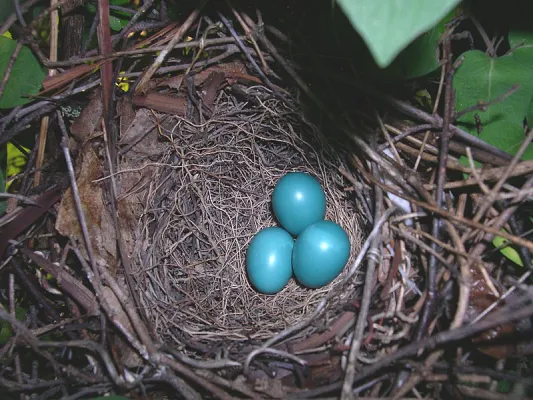
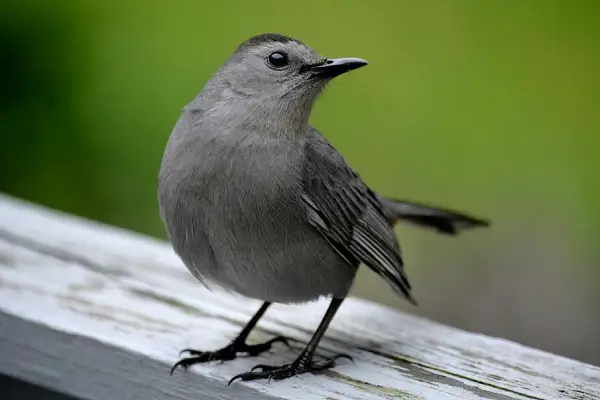
Related to mockingbirds and thrashers, gray catbirds are medium-sized songbirds found east of the Rocky Mountains. They breed in semi-open habitats with dense low-growth, urban, suburban, and rural areas.
In case you find a bulky cup nest in a shrub or tree, around 4 feet off the ground, there’s a big chance it belongs to gray catbirds. Females will use twigs, straws, bark, mud, pieces of trash, hair, pine needles, and rootlets, to complete their 2-inch-deep structures.
Gray catbirds lay 1-6 turquoise green eggs that occasionally have white spots. The eggs are around 1 inch long and 0.6 inches wide; females incubate them for 12-13 days.
After hatching, chicks are helpless and both parents will feed them. They fledge after 10-11 days and these birds will raise 2-3 broods per year. Brown-headed cowbirds may lay eggs in their nests, but catbirds will often destroy intruder eggs by pecking them.
2. Common Raven


These large all-black birds are one of the most widespread songbirds in North America. Common ravens are highly intelligent, very adaptable, and can survive in different areas, ranging from deserts to high Arctic tundra.
After doing various aerial acrobatics, demonstrating their intelligence, and ability to provide food, the pair will form and begin building their nest. Common ravens stay together for life but scientists recorded several instances of males visiting a female’s nest when her mate is away.
Common ravens construct deep bowl-shaped nests using sticks, twigs, roots, mud, bark, and fur, placing them on ledges, rock cliffs, trees, power-line towers, telephone poles, billboards, and bridges. After 9 days of hard work, their often uneven nests measure 5 feet in diameter and 2 feet high.
Female common ravens lay 3-7 dull greenish-blue eggs with brown spots once per year. They will incubate eggs that are 1.8 inches long and 1.3 inches wide for 20-25 days. During that period males will feed them.
Young fledge after 35-42 days from hatching and stay with their parents for another 6 months. You will most often find common raven eggs from late February.
Although adults are very long-lived, reaching over 20 years in some individuals, not all of their eggs will get the chance to hatch. Hawks, eagles, owls, martens, and other animals love feeding on them.
3. European Starling
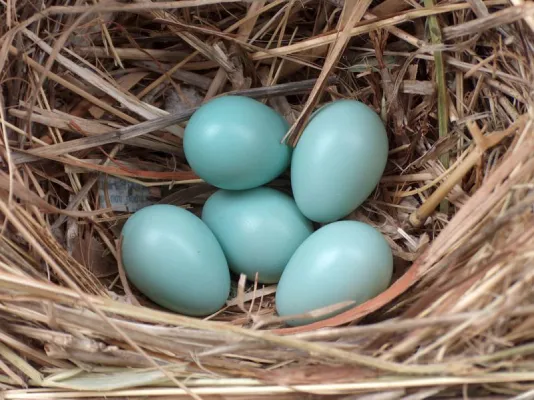

These medium-sized birds with white spots on their dark plumage were brought to North America in the 19th century. They managed to spread across the continent and are now present there year-round.
Common starlings, also known as European starlings, live in cities, parks, farms, open groves, and fields. Males will build their nests in cavities and decorate them with flowers and fresh green material to attract partners. They nest in natural hollows, woodpecker holes, birdhouses, giant cactuses (in the southwest), or in holes in buildings.
After pairing, females will throw out some of the material males used to seduce them, and finish the construction using twigs, leaves, feathers, grasses, and weeds. These birds typically breed during spring and summer.
Common starlings lay 3-6 eggs that are pale bluish-green. They are oval in shape, glossy, and measure around 1.2 inches long and 0.9 inches wide.
Both partners incubate them for 12 days and chicks will hatch helpless, blind for a week, weighing only 0.2 oz! They fledge after 21-23 days; these birds will raise 1 to 2 broods per year. Some females that couldn’t find a permanent partner will often lay their eggs in other pair’s nests.
4. Common Eider
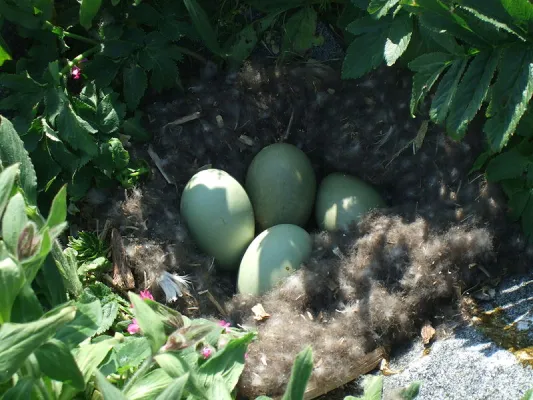

Common eiders are one of the largest sea ducks found in the northern hemisphere. These black and white birds breed along the coastline of Alaska, almost the whole coastline of Hudson Bay and eastern Canada, and the northern coast of Maine.
After males display exaggerated head movements, make low cooing calls, and flap their wings while rearing up out of the water, the partners will pair, mostly for life.
Common eiders are colonial breeders that nest on coastal islands in groups ranging from 100 to 15,000 individuals. Females are the ones to make the depression in the ground using their feet and line it with plant material and down. The nests measure around 10 inches across and 2.7 inches deep.
Common eiders lay 3-8 olive green eggs that have no marks. Their eggs are fairly large and measure around 3 inches long and 2 inches wide.
Females will incubate them for 24-26 days and if they need to leave their nests, will cover the eggs with the down. Chicks leave their nests shortly after hatching and go to water; most of them will find food on their own and start flying 65-75 days later. Some females might team up and work together in rearing their ducklings, doing what is known as “crèching“.
5. Least Tern


Least terns are small tern species that breed in North America and northern parts of South America. There are 3 subspecies found in the USA:
- S. a. athalassos – breeds on the Arkansas River, Mississippi River, Brazos River, Trinity River, and Rio Grande basins.
- S. a. antillarum – breeds on the Atlantic coast, ranging from Maine to the east and south coasts of the USA.
- S. a. browni – breeds on the Pacific coast, ranging from central California south to western parts of Mexico
These terns nest in colonies on beaches or islands on coastlines and rivers. They build their nests on the ground in a shallow scrape they occasionally line with pebbles, grass, and debris.
Females will choose the nesting sites and their nests are about 4 inches in diameter and less than an inch deep. Least terns lay 1-3 pale green eggs with black, brown, and gray splotches. Egg length varies from 0.9 to 1.4 inches and 0.8 to 1 inch in width.
Both parents incubate the eggs and if the weather gets too hot, they will dip themselves in water and then cool the eggs with their wet belly feathers. Incubation lasts 19-25 days and the chicks hatch with their eyes open and the ability to walk.
They will stay in their nests for a few days and find places to hide nearby. Both parents will feed them and the chicks make their first flights after 19-20 days. Least terns usually raise 1 brood per year but might attempt 2 in the south. They are monogamous and often stay together for several years.
6. Brewer’s Sparrow

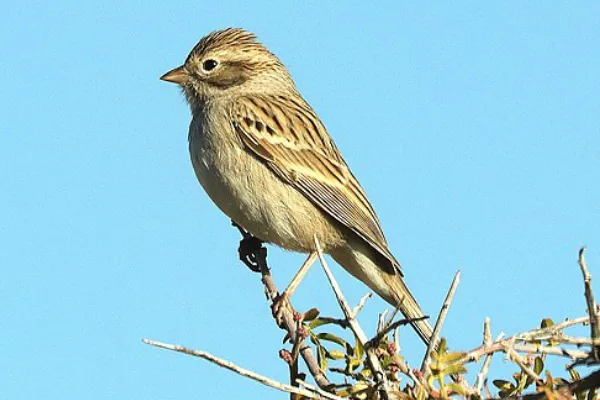
These tiny American sparrows got their name after the American ornithologist Thomas Mayo Brewer. Brewer’s sparrows breed in the western United States before moving to the southwestern USA and Central Mexico for the winter.
These birds are monogamous and breed exclusively in areas rich with sagebrush that provides cover. They nest in areas 1,830-4,100 feet above sea level that have dry grass and small roots these sparrows use to build their nests. It will take females around 4-5 days to complete their cup-shaped nests that measure 3.5 inches in diameter.
Brewer’s sparrows lay 2-5 bluish-green eggs with dark spots concentrated towards the larger end. The eggs measure 0.7 inches long and 0.5 inches wide and females incubate them for 10-12 days.
Brewer’s sparrows will usually lay their first set of eggs from early May to early August. If they are successful or if they lose some eggs, they will try to lay another brood around July.
After hatching, the young are mostly naked and will fledge after 6-9 days. Some birds like loggerhead shrikes will prey on their chicks and eggs while brown-headed cowbirds may parasitize their nests.
Read More: What birds lay blue eggs with brown spots?
7. Mute Swan


These stunningly large all-white species were introduced to North America in the late 19th century. Mute swans were named “mute” for being less vocal than other swan species and have gained somewhat of a negative reputation there for competing with native waterfowl and destroying native plants.
They are mostly monogamous and will form long-lasting bonds. Although scientists have observed situations where one mate will “divorce” the other for another, those that form bonds for at least a season are more successful at breeding.
They rarely nest in colonies and mostly start breeding around March and April. Mute swans breed in fresh and salt ponds, rivers, bogs, embayments, and creeks and streams that empty into large lakes and other bodies of water.
Females build the nests with males helping them gather the materials; nests are built on shorelines, small islands, or a mound in the shallows. It takes them around 10 days to complete and the construction measures 5 feet across the base and 1.5-2.1 feet high.
Mute swans lay 2-5 blue-green eggs that become paler as time passes. The eggs measure 3.5-4.6 inches long and 2.3-2.9 inches wide with females mostly incubating them for 34-41 days.
Chicks hatch with their eyes open and will be able to move pretty soon. Around 65 days later, they will make their first flights and will stay together with their parents through the first winter.
Want to learn more about the most common birds that lay brown-speckled eggs? Check out this article.
8. Cattle Egret
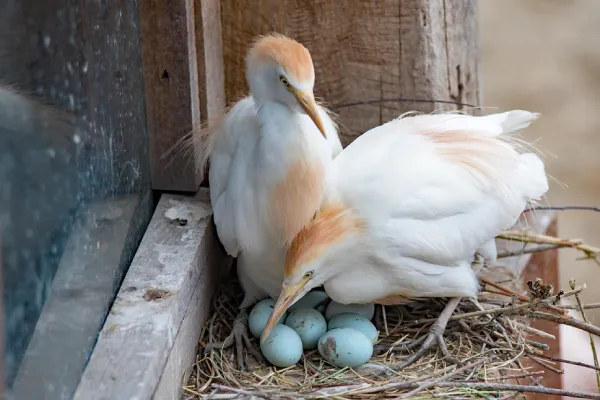
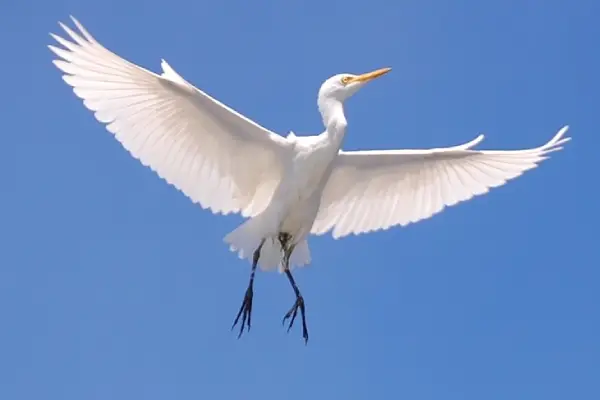
These stocky white bird nests in colonies, usually near bodies of water, together with other wading birds. Cattle egrets get buff plumes in the breeding season and breed in North America from California east to the Great Lakes and Maine and south to the Gulf Coast, from April to October.
They are common in coastal barrier islands, marshes, reservoirs, lakes, quarries, swamps, riverside woodlands, and upland forests. Males will establish territories and make various displays (neck stretching, plumes raising, making short flights) to attract females.
Females are the ones that mostly build the nests (males bring the materials) in trees or shrubs, often in swamps and islands. Using sticks, twigs, and soft plants, they will complete their shallow, untidy bowl-shaped nests that measure 2-12 inches deep.
Cattle egrets lay 2-4 sea green or pale blue eggs that measure 1.7 inches long and 1.3 inches wide. The eggs are oval-shaped and both partners incubate them for 22-28 days.
Both of them will also feed the hatched chicks that become fully independent after 45 days. These herons will parasitize the nests of other birds, laying in nests of snowy egrets and little blue herons; some females might also lay eggs in nests of other cattle egrets. In the USA, fish crows and black rats will often feed on these birds’ green eggs.
9. Black-crowned Night-Heron
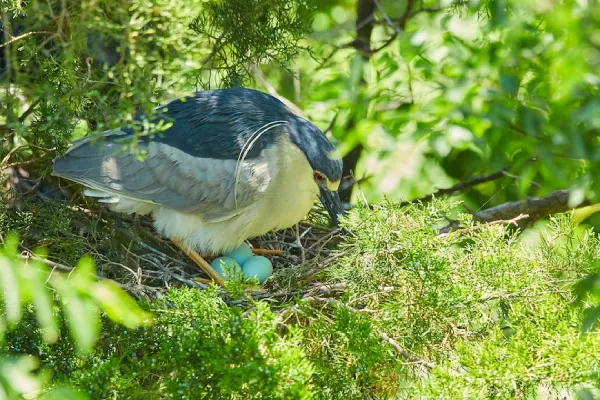
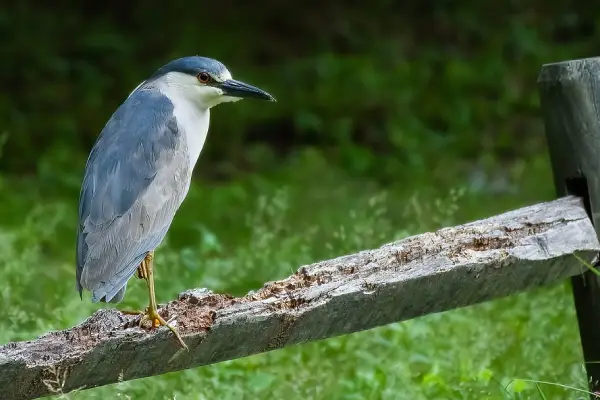
Black-crowned night herons, also known as black-capped night herons, are one of the most widespread heron species in the world. These nocturnal birds breed throughout most of the USA in fresh and salt-water wetlands.
Black-crowned night herons nest in colonies and build their nests in trees or in cattails – they will often make over 10 nests in a single tree. Males will begin building the nest, a platform made of sticks and twigs they take from the ground and after pairing with females, will let them finish the job. When complete, their nests measure 12-18 inches in diameter and 8-12 inches deep.
Black-crowned night herons lay 3-5 pale green eggs that measure 2.1 inches long and 1.5 inches wide. Both parents will incubate the eggs and also feed the chicks that hatch after 21-26 days.
They are mostly helpless, leave the nest 29-34 days later, and begin to fly at about 6 weeks of age. These birds are considered to be monogamous and will raise only one brood per season.
Read More: ID guide to red speckled bird eggs
10. American Crow
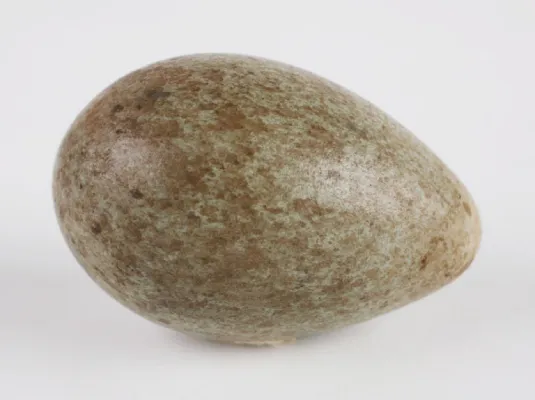
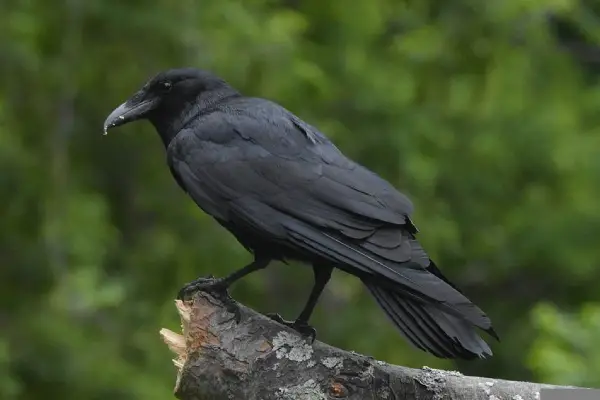
Often associated with trickery and death, American crows are large and intelligent birds with an IQ similar to that of chimpanzees. These long-tailed black birds are common throughout much of North America and can be seen around woodlands, farms, fields, shores, and towns.
American crows are monogamous and nest in trees or large shrubs. Both partners will help build the nest with offspring from previous seasons helping. Using twigs, pine needles, weeds, soft bark, and animal hair, they will complete a construction that is 6-19 inches in diameter and 4-15 inches deep.
Their egg-laying season starts relatively early, with some birds beginning incubation by early April. American crows lay 3-9 pale blue-green to gray-green eggs that are blotched with brown and gray. The eggs measure around 1.6 inches long and 1.1 inches wide; they might lay them twice a year.
Females incubate the eggs for 16-18 days and both parents together will helpers will feed the chicks. They are born naked, clumsy, and with eyes closed; after 20-40 days, the young will fledge. Snakes, raccoons, ravens, and cats will often feed on their eggs.
Read More: What are some birds that lay red eggs?
Summary
Green eggs are a unique and beautiful sight to behold. They can be found in different bird species, including herons, crows, terns, ravens, starlings, and many others.
Whether you’re a bird watcher, farmer, or just curious about these stunning eggs, we hope you found this article helpful. If it did, feel free to check out our photo ID guide on the most common white bird eggs with brown speckles found in backyards.